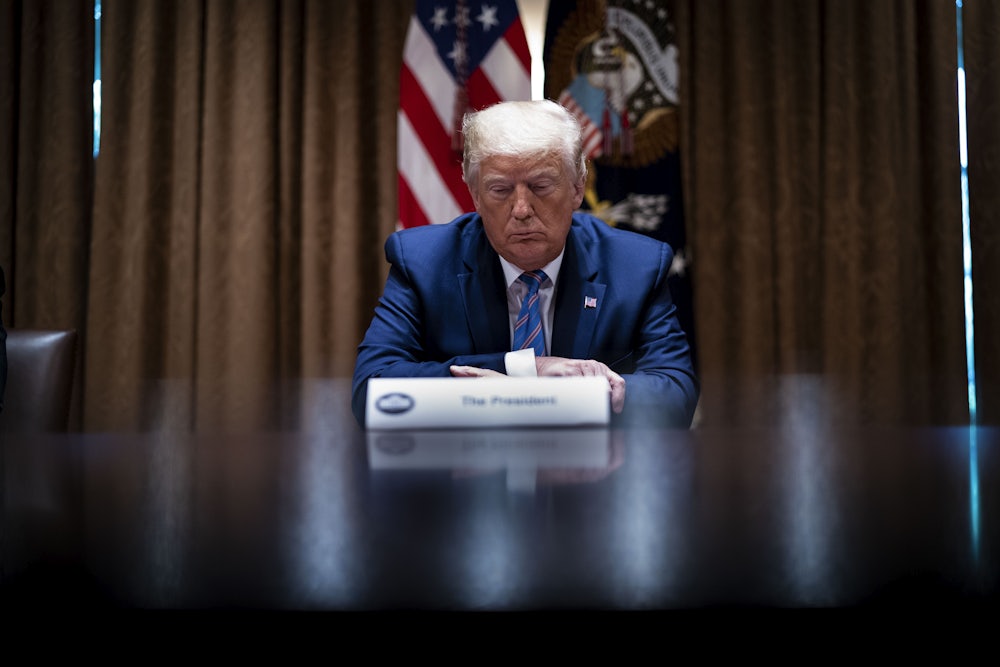If you had any doubt that America is a gerontocracy, consider that we’ve been talking for three days now about the president’s uncertain gait as he descended a ramp at West Point on Saturday. On the following day, Donald Trump turned 74—making him one year older than Ronald Reagan when, in the recollection of his son Ron Jr., he appeared “lost and bewildered” during a 1984 reelection debate with Walter Mondale. (Reagan nonetheless went on to win a second term, during which he displayed more visible signs of mental deterioration.)
In 2020, as in 1984, cognitive function will likely play no decisive
role in our presidential balloting. That’s not, mind you, because Trump is a
shoo-in for reelection (at the moment he seems poised for defeat). Instead, it’s
because Trump’s opponent, Joe Biden, will be 78 on inauguration day next year—and
he’s a little unsteady himself (as Trump never tires of suggesting, in a barrage
of Twitter asides about “sleepy Joe”).
America’s upper governmental reaches are remarkably old—older, in fact than
the much-mocked Soviet Politburo at the time of Leonid Brezhnev’s death, when its median
age was a comparatively sprightly 71. There are a variety of reasons for this,
including the aging of the Baby Boom and great health strides in recent decades
for the over-70 set. But the real determining factor, I think, is that the
voting population is very, very old. In 2016, voters age 65
and older represented only 15 percent of the electorate but accounted for
nearly 30 percent of all ballots cast, thanks to their 71 percent turnout. In 2020, this cohort will represent nearly one-quarter of the electorate—and consequently
could account for one-third or more of all ballots.
Older voters were once a reliably Democratic constituency,
thanks in large part to their reliance on Medicare and Social Security. But
during the past couple of decades, they’ve leaned Republican, and in 2016 they were a key Trump
constituency. Fifty-two percent of voters aged 65 and older (and 58
percent of whites aged 65 and older) went for Trump in 2016, according to exit
polls, even as Trump lost voters aged 18–44. As a bastion of the fabled Trump
base, the elderly vote ranks up there with the evangelical vote and the white
blue-collar vote.
But bases can become shaky, and Trump’s support among the
over-65 set is now very wobbly indeed. Most national polls show Trump’s backing
in this demographic is falling, and some show him losing this group outright to
Joe Biden. For example, a CNN poll conducted June 2 to 5 showed Biden beating
Trump among voters aged 65 and older by 51 to 47 percent (and had Biden beating
Trump by 14 points). The slippage is especially pronounced among older women,
who divided about equally in 2016 between Trump and Hillary
Clinton but favored Biden in a May 20 Quinnipiac poll by 22 points.
Trump is aware of the problem, but he can’t seem to stop doing
things to alienate this group. He’s minimizing the health threat from the coronavirus—at a time when at least 40 percent of Covid-19 deaths have occurred in
nursing homes, according to The Wall Street Journal. He opposes voting by mail
(never mind that Trump voted for himself by mail in the March 17 Florida
primary). He’s suggested that Martin Gugino, the 75-year-old protester whose
skull was fractured on June 4, when a Buffalo cop pushed him to the ground, was
“an antifa provocateur” who “fell harder than he was pushed.” And Trump, who
once prided himself on refraining from traditional conservative calls to cut
Social Security and Medicare while campaigning for president, has proposed reductions
to these programs now that he’s in office, and he’s started to speak more
openly about that.
The gerontocratic bias in the American electorate creates all sorts of problems for our democracy. The septuagenarian-led status quo keeps fresh faces out of Congress and makes it harder to bring new ideas into the political conversation. It made it possible, just barely, for a person like Donald Trump to get himself elected president. The best way to address these problems is to increase electoral participation by younger voters.
But barring such an upsurge—which would not play to Trump’s demographic strengths—the gerontocracy must impose some internal discipline, and something like that appears now to be happening. It’s increasingly unlikely that elderly voters will invite Trump back for a second term. In 2021, we’ll still watch the president walking very carefully down the occasional staircase or ramp. But he will probably be a different president.
